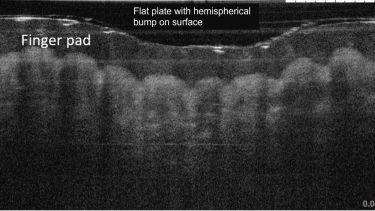Human Interactions
We specialise in applying mechanical engineering concepts to situations that involve physical interactions between humans and products, devices and surfaces.

Our work falls under five main themes:
- Behaviour of human skin and tissue under loading
- Development of synthetic testbeds for human interactions
- Hand-object interactions
- Shoe-surface interactions
- Understanding human interactions to be applied in other areas such as robotics, healthcare and sport
Our research aims to improve the understanding, performance, comfort, and experience of human-product interactions. We work closely with industrial partners and organisations on the tribological, and dynamic problems associated with a wide range of products. The image shows an Optical Coherence Tomography (OCT) image of a finger pad sliding across a flat plate that has a hemispherical bump on its surface. This helps us to study the link between the friction and the morphology of a finger pad.
Our Expertise and Activities
- We are experienced in the development of biofidelic systems that simulate aspects of physical human interaction and can be used in place of human participant testing or applied to robotics.
- We have expertise in the understanding of the effects of surface roughness, moisture, topical treatments and loading on skin tribology, as well as a range of medical, sports and consumer applications.
- We work with a range of industry partners and organisations, often in the sectors of consumer goods, sports products, cosmetics, robotics and healthcare to develop design and test methodologies for products that include human interactions.
- We have a number of test machines including tribometers, a vibration rig, shoe-traction measurement device and 3D scanner which are used to aid the improvement of products and, ultimately, enhance the health and/or experience of consumers.
Current and Past Research Projects
-
TrEnT: Tribology as an Enabling Technology, to be applied in robotics applications (sponsored by EPSRC).
-
Using Optical Coherence Tomography (OCT) to understand the properties that affect the friction of human skin (sponsored by EPSRC).
-
Development of an instrumented tactile finger to understand the role of tribology for grasping applications
-
Development of a synthetic skin test bed for the assessment of beauty and personal care product consumer experience
-
Understanding interactions with human intestinal tissue for capsule endoscopy
-
Friction between human skin and incontinence pads in the presence of topical barrier protection treatments
-
The assessment of medical gloves in-situ applications
-
The effectiveness of chalk as a friction modifier for finger pad contact with rocks of varying roughness
-
Shoe-surface tribology in hard court tennis
- Friction of snooker cue tip-cue ball interaction
Contact
Prof Matt Carré, M.J.Carre@sheffield.ac.uk
